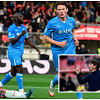Maradona must be smiling

While the fans of Italian football continue to struggle to convince their peers from the English Premier League and LaLiga about the relevance of Serie A in European footballing hierarchy, it is with a renewed optimism that they can now boast about Napoli – the new entertainers of European football.
The Serie A may have lost much of its sheen following the Calciopoli scandal in 2006 and the overall economic downturn in the peninsula, causing the once-world's-best football league looking enviously across its shoulders. However, even during the relative lull of the last decade-and-a-half, the country has seen some fascinating revolutions, albeit for brief periods, from some of the lesser clubs.
First it was Zdenek Zeman's ultra-attacking Pescara side in Serie B in 2011 – a perfect retort to those who still like to believe that Italian football relies mostly on defensive pragmatism rather than attacking flair.

Then there was Sarriball at Napoli, a style of play which impressed one and all, including Pep Guardiola himself. Next came Gian Piero Gasperini's Atalanta and Roberto de Zerbi's Sassuolo, both teams turning heads not just in the peninsula but also across Europe.
Each team had their own philosophy and style of play, and was entertaining and successful to an extent, in their own way. Latest in that line and arguably the most entertaining of all is Luciano Spaletti's Napoli.
The current Napoli side is rightly drawing comparison to the one led by Diego Maradona in the late '80s, which won two Serie A titles alongside one UEFA Cup, one Coppa Italia and one Supercoppa title.
Since the shaven-headed Tuscan took over from Gennaro Gattuso ahead of the 2021-2022 season, Napoli have been one of the most entertaining sides in Europe. After finishing a creditable third in the Serie A table last season, The Blues have unleashed their full array of entertainment this season.
They have scored a whopping 64 goals already in 27 matches – behind only Bayern Munich, Manchester City and Paris Saint-Germain across the top five leagues in Europe. They have also scored the most goals in the Champions League group stage and are already into the quarterfinals of Europe's premier club competition for the first time following a 5-0 aggregate win over last season's Europa League winners Frankfurt. At home, they are all but assured of a third Serie A title with a 19-point lead after only 27 match days.
But something that might easily escape notice of casual observers is the fact that Napoli have been the second-most frugal team across top five leagues, second only to Xavi's Barcelona. And they have suffered only two defeats in the league thus far – the best record alongside the Blaugrana.
This is what sets Spaletti's side apart from the Pescaras and Atalantas and the Sassuolos of the past few years. The Partenopei have been able to entertain while making sure they do not endanger their title ambitions by doing so.
The biggest surprise is, Napoli are tearing up Serie A and Champions League order after having experienced an exodus of star players, including Lorenzo Insigne, Dries Mertens, Fabian Ruiz, and Kalidou Koulibaly.
The Neapolitan revolution did not come in one day, it was 20 years in the making. Once bankrupt, the club was lifted from the depths of Serie C1 by the ambition of its flamboyant owner Aurelio de Laurentis. With their lofty ambition, there was some astute management as well, who made some bargain buys in the preseason transfer window, offloading ageing stars and replacing them with young and promising players. Some of those acquisitions include Kim Min-Jae, Frank Anguissa, Mathias Oliveira and, of course, Khvicha Kvaraskhelia, with the latter having already become a star after forming a lethal partnership with Victor Osimhen.
The current Napoli side is rightly drawing comparison to the one led by Diego Maradona in the late '80s, which won two Serie A titles alongside one UEFA Cup, one Coppa Italia and one Supercoppa title.

Before Maradona arrived in the peninsula, no team from the south of the country had ever won a league title. The power structure in football was symbolic of the great north-south divide, which was probably more real in Italy than anywhere else at that time. The Argentine great changed it all and gave the eternally neglected Neopalitans and the southerners a reason to take pride in, an occasion to see the 'superior' northerners eye to eye. It was a watershed moment in the history of Italian football, and indeed of Italian society as a whole where football is no lesser a religion than Catholicism.
Since Maradona's acrimonious departure from Italy though, Napoli had slipped into obscurity as the hegemony of the north, perpetuated by the likes of Juventus, Milan, and Internazionale once again set in.
But it looks like de Laurentis and Spaletti are bringing back the good times with the class of '22-23. And Maradona would surely be cheering from above when the likes of Osimhen and Kvaraskhelia proudly hold aloft the coveted Serie A trophy at the Diego Armando Maradona Stadium.

 For all latest news, follow The Daily Star's Google News channel.
For all latest news, follow The Daily Star's Google News channel. 







Comments